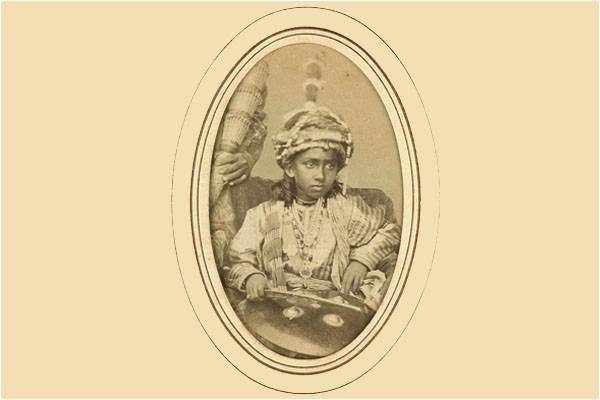
Shown here is a half-length seated carte de visite portrait, a detail of a larger photograph of Sir Sadiq Muhammad Khan, Nawab of Bahawalpur by Bourne and Shepherd, c.1870. Bahawalpur was controlled by the descendents of the Daudputra family. Sir Sadiq Muhammad Khan (1862-99) succeeded as Nawab of Bahawalpur in 1866. While he was a minor, the affairs of state were administered by British and Indian officers. He was created a Knight Grand Commander of the Most Exalted Order of the Star of India in 1880. Sadiq Muhammad Khan’s administration developed a canal system to improve irrigation and established a better public education system.
The Royal House of Bahawalpur is said to be of Arabic origin and claim descent from Abbas, progenitor of the Abbasid Caliphs of Baghdad and Cairo. Sultan Ahmad II, son of Shah Muzammil of Egypt left that country and arrived in Sind with a large following of Arabs ca. 1370. He married a daughter of Raja Rai Dhorang Sahta. Amir Fathu’llah Khan Abbasi is the recognized ancestor of the dynasty. He conquered the bhangar territory from Raja Dallu, of Alor and Bhamanabad, renaming it Qahir Bela. Amir Muhammad Chani Khan Abbasi entered imperial service and gained appointment as a Panchhazari in 1583. At his death, the leadership of the tribe was contested between two branches of the family, the Daudputras and the Kalhoras. Amir Bahadur Khan Abbasi abandoned Tarai and settled near Bhakkar, founding the town of Shikarpur in 1690. Daud Khan, the first of his family to rule Bahawalpur, originated from Sind where he had opposed the Afghan Governor of that province and was forced to flee. The Nawab entered into Treaty relations with the HEIC, February 22, 1833. The state acceded to the Dominion of Pakistan on October 7, 1947 and was merged into the state of West Pakistan on October 14, 1955.
The Royal House of Bahawalpur is said to be of Arabic origin and claim descent from Abbas, progenitor of the Abbasid Caliphs of Baghdad and Cairo. Sultan Ahmad II, son of Shah Muzammil of Egypt left that country and arrived in Sind with a large following of Arabs ca. 1370. He married a daughter of Raja Rai Dhorang Sahta. Amir Fathu’llah Khan Abbasi is the recognized ancestor of the dynasty. He conquered the bhangar territory from Raja Dallu, of Alor and Bhamanabad, renaming it Qahir Bela. Amir Muhammad Chani Khan Abbasi entered imperial service and gained appointment as a Panchhazari in 1583. At his death, the leadership of the tribe was contested between two branches of the family, the Daudputras and the Kalhoras. Amir Bahadur Khan Abbasi abandoned Tarai and settled near Bhakkar, founding the town of Shikarpur in 1690. Daud Khan, the first of his family to rule Bahawalpur, originated from Sind where he had opposed the Afghan Governor of that province and was forced to flee. The Nawab entered into Treaty relations with the HEIC, February 22, 1833. The state acceded to the Dominion of Pakistan on October 7, 1947 and was merged into the state of West Pakistan on October 14, 1955.

